Back to The Riders of the Plains.
The following is an excerpt from The Riders of the Plains: A Reminiscence of the Early and Exciting Days in the North West (1905), by Cecil Edward Denny. This work is in the public domain.
Continued from Chapter XVII- Winter in Calgary, 1877.
Chapter XVIII
Indian Medicine Dance
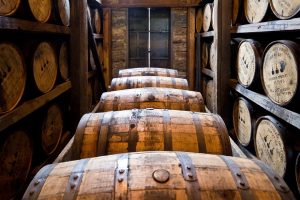 THE TRADE OF WHISKY to the Indians had by this time pretty well stopped, although occasional instances there were of it being traded in the camps. But the quantity of whisky brought into the country was still large, as a great deal was sold to the police and other whites in the country. The very poorest quality, costing in Benton about $4 per gallon, would readily sell at Macleod or any of the other settlements for even as high as $10 per bottle. A very large quantity was sold, and although the penalty was most severe, the fine ranging as high as $300 for the third offence, the profits were sufficient to keep the trade in full swing, and all chances of capture were taken in bringing the liquor in.
THE TRADE OF WHISKY to the Indians had by this time pretty well stopped, although occasional instances there were of it being traded in the camps. But the quantity of whisky brought into the country was still large, as a great deal was sold to the police and other whites in the country. The very poorest quality, costing in Benton about $4 per gallon, would readily sell at Macleod or any of the other settlements for even as high as $10 per bottle. A very large quantity was sold, and although the penalty was most severe, the fine ranging as high as $300 for the third offence, the profits were sufficient to keep the trade in full swing, and all chances of capture were taken in bringing the liquor in.
All through the years of prohibition in the Territories it was found impossible to totally stamp out the liquor trade, and it could always be procured at a high price at any of the small towns or settlements in spite of the constant patrolling along the line, and the close watch kept on all suspected whisky traders. Many, of course, were caught, and fined or imprisoned, but the profits were so enormous that the fines would generally be paid, the trader nearly always remaining in the business. At Fort Macleod in the old days, the vilest compounds were sold, Jamaica ginger being a favorite. It sold at $1 for a six ounce bottle, and was composed of alcohol and a few drops of extract of ginger. The men who sold these compounds made plenty of money, but it was easy come and easy go, as all of them were gamblers, and as gambling was rife at all the posts, this ill-gotten money quickly changed hands. Liquor permits were granted in those days by the lieutenant-governor, but applications had to be recommended, and then only two and a half gallons were granted, supposed to be for medical purposes.
These permits were much abused, being transferred indiscriminately. Men detected with hundreds of gallons of liquor in their possession had permits to cover it all, and therefore it could not be touched, although the permits may have been for several different individuals.
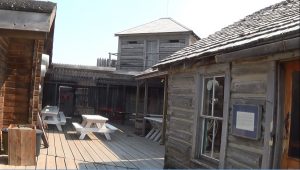
In the years 1877 and 1878 many of the men in the force took their discharge, the term of service being at that time three years. It was changed a few years afterwards to five, which it now is. Many of these time-expired men took their discharge in the country, and either worked out for wages, or took up farms of their own, and bought a few head of cattle and horses. Most of them settled in the vicinity of Fort Macleod, and a good many in the north along the Saskatchewan river. This was the beginning, in a small way, of the stock industry in Southern Alberta. A few men from Idaho and Montana also brought in small herds of cattle, and settled in and near Macleod. Some of them went in for farming and gardening, making large profits out of their grain and vegetables, which they could always sell to the police, oats often fetching 5 cents per pound, and potatoes 7 cents. Several of the police who took their discharge in the country had saved considerable money, and in some cases brought in quite large bands of cattle, which have largely increased, making the owners wealthy men to-day.
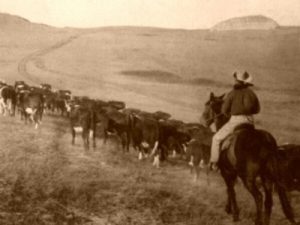 In the spring of 1878 I contracted with two men from southern Montana, Lynch and Emerson by name, to drive in the following fall 100 head of yearling heifers, which they agreed to deliver at Calgary for $10 per head. Cattle could be purchased at that time in Montana and Idaho at a very low figure. These men delivered the cattle at the time stipulated, bringing in also several hundred head of cows and steers, which they had a ready sale for, also making the first start for themselves. They in after years became large stock owners. This was the first year cattle were brought into the western Territories, and our diet of buffalo meat was changed for that of domestic beef, I.G. Baker & Col having the contract to supply the force, which they did by driving in herds of beef cattle and opening butcher shops at different posts. Their contract p[rice for beef was 14 cents per pound, and they made enormous profits on their cattle, which they bought at a low figure in Montana.
In the spring of 1878 I contracted with two men from southern Montana, Lynch and Emerson by name, to drive in the following fall 100 head of yearling heifers, which they agreed to deliver at Calgary for $10 per head. Cattle could be purchased at that time in Montana and Idaho at a very low figure. These men delivered the cattle at the time stipulated, bringing in also several hundred head of cows and steers, which they had a ready sale for, also making the first start for themselves. They in after years became large stock owners. This was the first year cattle were brought into the western Territories, and our diet of buffalo meat was changed for that of domestic beef, I.G. Baker & Col having the contract to supply the force, which they did by driving in herds of beef cattle and opening butcher shops at different posts. Their contract p[rice for beef was 14 cents per pound, and they made enormous profits on their cattle, which they bought at a low figure in Montana.
The summer of 1878 was an unusually rainy one, the rivers all being very high, and there being no boats at that tie the crossing was always most difficult and dangerous. The Old Man’s river at Macleod had changed its course, breaking through its banks, and overflowing the bottoms on which the fort and settlement were built. Several houses in the village were washed away, even the fort was nearly flooded. The bottom on which the fort was built was converted into an island, with a branch of the river both north and south, and the river now flowed over the spot where buildings once stood, and where the main road through the village ran.
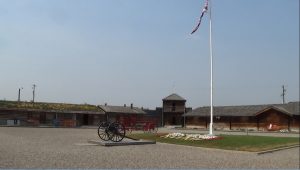
The fort at Macleod had been improved, as the mud floors and roofs had given place to lumber, a small saw mill having been shipped up the Missouri river, and then taken by bull team to Macleod. It cut, however, only a limited quantity of lumber. Great difficulty was experienced in booming the river, as in high water these mountain streams are very swift and many thousand of our logs were carried down the river by the breaking of the boom, and never recovered. Logs had to be cut and driven down the river for sixty miles and our force being so small, and the work increasing yearly, it was found that men could not be spared for this work. The buildings then only received repairs where absolutely necessary, and in wet weather they were decidedly uncomfortable. At Calgary, Fort Walsh, and Edmonton, halfbreeds were engaged to cut lumber by whipsaw, and a great deal was got in this manner. At Edmonton plenty was to be obtained, and the fort at that place was comfortable and substantial. Horses for the use of the force were being sent up from Canada, via the Missouri river, but they were found to be not nearly as serviceable as those bred in the country, which could stand the hard winter journeys, without grain, and keep in good condition on the wild grass, while the Canadian horses, used to stabling and good feed, very soon become useless, or died from hardship.
A good many mares were brought into the country by the police in 1874, and a herd of them was started at Pincher creek, thirty miles west of Macleod, with the purpose of breeding for the force. A good, well bred stallion was sent up, but although a good many colts were bred which turned out well, the scheme was not a success, there not being men enough to spare for the farm. A great many of the mares having been, as it was supposed, stolen, the idea was abandoned, and the herd broken up, the mares being returned to duty.
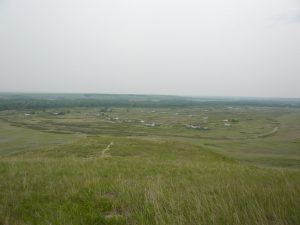
In July, 1878, I proceeded to the Blackfoot crossing to notify the Blackfeet of the date of their payments, and found that tribe, and also the Sarcees, camped on the old treaty ground. They had just finished their medicine dance, which this year had been held with great ceremony, many braves having been made, and much talk of going on the war path against the Sioux indulged in.
Tobacco had been sent to the Blackfeet from the Sioux, with messages of peace, the smoking of tobacco sent from one hostile tribe to another, and smoked by them, being considered the end of hostilities. However, the Blackfeet refused to smoke this tobacco, and were more hostile against the Sioux than ever, considering that their presence in the country had much to do with the diminution of the buffalo, which were yearly becoming fewer in numbers.

The Blackfeet had a curious custom, and one I had found among no other Indians, of smoking tobacco at the medicine dance grown from seed by themselves. They had no record of when or where this seed was obtained, but as far back as they had any record, the custom prevailed among them. This tobacco seed was carefully gathered when ripe by their medicine men, and planted in a particular spot at the Blackfoot crossing, and gathered and dried by them before the medicine dance was held. It was very much venerated. I have seen the tobacco growing and it seemed the ordinary plant, and did remarkably well.
This custom, I believe, has died out, and the seed is lost, but it must have continued for ages, and it would be interesting to know from where the seed was first obtained, and how they got the knowledge of its cultivation.
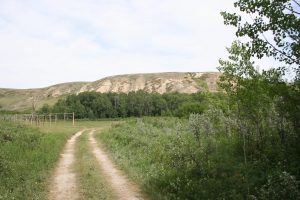
The Blackfoot crossing, or the “Ridge Under Water|, as it was termed in Blackfoot, had been an old camping and burial ground of the Blackfoot tribe from time immemorial, and was in fact looked upon by all the tribes of plain Indians with veneration. That, prior to the advent of the Blackfeet into the country, many hundred years ago, some warlike tribe of Indians existed here and made the crossing one of their chief camping places, is shown by mounds raised in a half moon shape, there having been embankments thrown up of considerable height, the remains of which still exist, the crescent shape being clearly defined. Indians have informed me of pieces of pottery having been dug up there. I have myself found flint arrow and spear heads, also stones worn into grooves made by the sharpening of the flint weapons, near these old mounds.
It would be worth while, I think, to thoroughly search this locality, as no doubt many relics could yet be obtained.
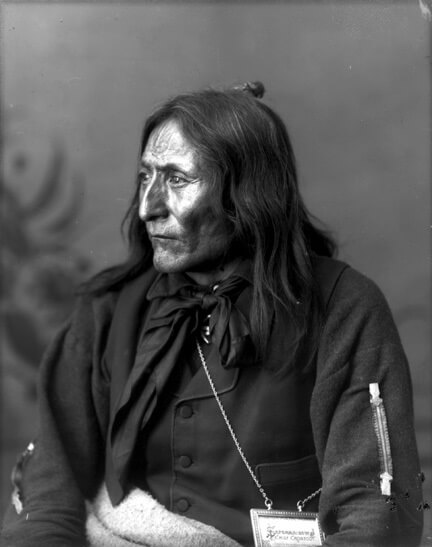
I found Crowfoot and his chiefs and Indians in very bad humor, and explained to them that the Bloods were to be paid separately, at a certain date, and also that they would have a separate reservation in the south, and that surveyors would come up the following year to lay out all the reserves. I also asked him to set the time for the Blood and Blackfoot payments to be made.
This for two days he would not hear of, insisting that the Bloods and Blackfeet should have their reserve together, as agreed in the treaty the previous year, and also that the Bloods should come to the crossing, Blackfeet and Bloods to be paid together.
It was about the most difficult job I ever undertook to make him agree to the change, and it was only after two days’ steady talk that he finally gave in, and the day was set for the Blackfeet payments.
The Blackfeet had many complains to make, the principal one being that of the Sioux, together with the scarcity of buffalo, and the entry into the country and on to the plains, of the Crees from the north, whom, they claimed, never previous to the advent of the police, dared to hunt buffalo in their country.
I, however, told them to bring up all their grievances at the time of the payment, about a month from that time, and I then returned to Fort Macleod, after notifying the Stony Indians at Morleyville, and setting the date of their payment at that place, after that of the Blackfeet had been finished.
Word was sent to the commissioner at Fort Walsh, of all the different dates agreed upon, and I remained at Fort Macleod until his arrival, some time afterwards.
Continued in A Strange Adventure.







Leave a Reply